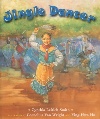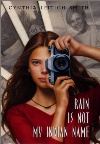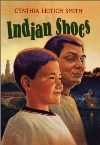Cynthia Leitich Smith writes books for children that, as she has said, "ask difficult questions." An enrolled member of the Muscogee (Creek) Indian Nation, her three books have focused on Indian characters, but have universal themes.
Raised in Kansas City, the author has degrees in journalism and in law. She has lived abroad (Paris), and in Illinois (Chicago), Oklahoma, and Hawai'i. She and her writer husband, Greg Leitich Smith, now make their home in Austin, Texas.

Jingle Dancer (Morrow/Harper, 2000) is about Jenna, a young girl who longs to dance at the upcoming powwow of her Muscogee Creek-Ojibwe tribe. When time grows short and she can't get the tins needed to roll "jingles" for her dress, she turns to the women of her family and intertribal and mixed-race community. Their efforts save the day and Jenna dances. Written for ages 4 to 8, Jingle Dancer is beautifully illustrated by the watercolor team of Cornelius Van Wright and Ying-Hwa Hu.

Leitich Smith's highly-praised second book, Rain Is Not My Indian Name (Harper/Listening Library, 2001), finds a teen of mixed heritage devastated by the death of her friend. Again, her family and her tribal community help her mourn and heal.

Indian Shoes (Harper, 2002, illustrated by Jim Madsen) features Ray Halfmoon, a young Oklahoma boy orphaned when his parents die in a tornado and sent to live with Grampa in Chicago. Their story unfolds in a collection of deceptively simple tales of fishing, sports, and stars. Despite the generation missing between them (the boy's parents), and despite their own generation gap, grandfather and grandson find that a greater, deeper ancestral connection keeps the spirit of the past alive and keeps them going.
Leitich Smith also has created and maintains a prize-winning website. cynthialeitichsmith.com is a 200-page children's and young adult literature site selected for Writer's Digest's top ten list. It contains a book of the month, updated featured links, and interviews with prominent and upcoming children's book authors and illustrators. There is a page for multiculturalism and sexual orientation topics, a vast range of bibliographies, and loads of children's authors' resources. Leitich Smith sends a quarterly e-zine to devotees.
—AQ

Jul '02 [Home]
Interview
Children's Author, Cynthia Leitich Smith
by Alexis Quinlan
AQ: Your subtle rendering of a Native American boy and his grandfather was wonderful in Indian Shoes. [Excerpt] Whether they were traipsing the "cracked sidewalk of a steel and stone city" in Chicago or planted upon the red earth of Oklahoma, they were fully and firstly recognizable as humans.
CLS: Thank you. One element long missing from Native American children's literature is the simple fact that Indian people are real-life human beings. For so long the industry has offered either stereotypic "savages" or eco-supernatural beings that many young readers have been misled to believe that Native kids don't have feelings or everyday problems or even exist in the contemporary world.
For non-Indian kids, this can lead to prejudices against Native Nations and their citizens, to a false image of the original and surviving peoples. For Indian kids, it's even more disturbing, the idea of seeing their people depicted in untrue and negative ways.
AQ: I tracked a tale of deep connection despite loss and longing—a connection between the boy Ray and Grampa despite the lost generation between them, as well as a link between the "steel and concrete" of Chicago and the red earth of Oklahoma. We forget how intelligent children are about loss. Told from Ray's point of view, we see him understand his grandfather—his wanting the shoes, homesickness, car trouble—until the very end, where the grandfather has something to teach him.
CLS: Children are tremendously observant. They have to be. So many of us grown-ups are busy trying to hide and protect them from what they already know to be true that oftentimes they're afraid to break it to us when something goes wrong. By trying to shield them so completely, we effectively leave them to fend for themselves.
AQ: In reading your tale, I thought of the Greek word pothos, for 'yearning,' always used in connection with Alexander the Great. Pothos made the conqueror Alexander want to travel, and to learn more about his own divinity. I see these two, grandfather and boy, as heroes of a sort, only they deal with the world as it comes, patiently waiting to take their turn, to go fishing for something bigger.
to everything that is above and below.
CLS: Ray and Grampa Halfmoon are everyday heroes. They face their challenges with good humor and determination. That doesn't mean they never get discouraged or embarrassed or frustrated, but in the end, they keep going. They may not win the blue ribbon for their painting or get farther than a walk to first base, but they ultimately win in the ways that matter.
In the last chapter, they stand very much on the red earth, side by side, and take a moment to marvel at the heavens, the real-life magic and mysteries of creation and the universe. It puts them in perspective. Small, in some ways, in the overall scheme of things, but also connected to everything that is above and below.
Grampa, like many urban Indians yearns for home, to stand there on that red clay dirt in Oklahoma, to connect his grandson both to those lands, those peoples, but also the memory of the lost generation between. Ray longs to be there beside him and to help make it okay when they're anywhere else.
AQ: Indian Shoes is a bricolage of six short stories. The first, also called "Indian Shoes," introduces Ray Halfmoon and Grampa as they duck into the Murphy Family Antique Shop. Grampa lights on a pair of moccasins that "put [him] in the mind of bein' back home." Recognizing his nostalgia, Ray returns to the shop but can't outbid the librarian who wants them for a school display. However, he can persuade her to trade the moccasins, of dubious origin, for his own high-top sneakers, which have definitely been Indian worn. In a lovely ending, the shoes are up for display and Grampa has his mocs. I know that the moccasins are featured once more, but can you talk about why you named the whole book 'Indian Shoes'?
CLS: We named the book 'Indian Shoes' because it's a collection of daily life stories with Native characters and sensibilities. Although that one story has an explicit cultural tie to its focus, most other tribal references are more integrated into the background. We wanted to emphasize the idea of these everyday journeys, from Native points of view, but also in territory familiar to many young boys of Ray's age, such as a ball game.
AQ. The "something bigger" is the sense of connection to the shooting stars, the earth, and, of course, to the missing father. I think it's difficult, in books as in life, to find adults who are honest with kids about loss. There was something grand about this grandfather who planned fishing trips for the wee hours. He headed out each morning, not pushing the boy to join, just waiting to share his experience of what amounted to spiritual connection. What are your thoughts on the relationship between traditional cultures and modern politics?
as it really fictionally unfolds.
CLS: I've been urged to be more political, to be less political, or to be political in a way that appeals to mainstream liberals rather than Indians. People have read things into my work that are simply baffling to me.
Ultimately, I have to shrug it off. My primary duty is to my characters and my young readers. To them, I owe truth as the fictional folks see it, even when it makes me uncomfortable. No single agenda is sympatico with life as it really fictionally unfolds. Sure, I'm a political animal. We all are, to some degree. But my characters aren't me.
AQ. In interviews, Sherman Alexie jokingly (I think) admits to using his heritage to garner an audience. Louise Erdrich has emphasized her tribal roots in her work and in her life. How are you related, and unrelated, to them—or to other Native American authors?
CLS: Speaking of relations in the strictest sense, my closest tribal ties would be to Joy Harjo, the wondrous Creek poet who also has done a lovely picture book, The Goodluck Cat (Harcourt, 2000). I find her poetic work to be comforting, inspiring and unsettling—all reactions I hope for in opening a volume. Beyond that, there is certainly an increasing community of Native voices. Being a children's author, I pay particular attention to fellow Native children's writers like Beatrice O. Harrell (Choctaw), Cheryl Savageau (Abenaki), Joseph Bruchac (Abenaki), Kathleen (Mohawk) and Michael Lacapa (Apache-Hopi-Tewa), Richard Van Camp (Dogrib), Luci Tapahonso (Navajo), George Littlechild (Plains Cree), Simon Oritz (Acoma), and Louise Erdrich (Ojibway), among others. A handful, like Oritz and Erdrich write for both children and adults.
Egyptian, and Latino Americans, among others.
Sherman Alexie is enormously talented, of course, and my favorite of his books is The Lone Ranger and Tonto: Fistfight in Heaven. I also have a tremendous affection for and admiration of the work of Linda Hogan, a Chickasaw author and poet. My greatest weakness is for short stories and novellas—must be an MTV generation side effect.
In terms of my own writing that's Native-related, I don't actually know that it does so much for bringing in an audience. Every year there are many children's books that feature Native characters and themes, and while the situation is improving, the sad truth is that those with stereotypic depictions often fare far better in the market. So to me, it's not so much a market niche as just a natural extension of perspective. The world I live in, that children live in, is multicultural. I can't imagine writing realistic stories and not reflecting that aspect of reality. While my Native characters have been central to my work, a close reading will reveal that they still live in diverse worlds; diverse within Native America, intertribal, as well as more broadly. For example, a close reading of Indian Shoes will reveal a neighborhood that includes Irish, Egyptian, and Latino Americans, among others. Even in the wedding story, the bride is a Choctaw and the groom is Polish-Menominee. I'm a mixed blood Creek married to a Japanese-German American.
AQ: I'm a morning writer. I suspect it's partly from distrust of my own unconscious, that the imagination I wake up with won't last the day, much less the evening, so I have to snatch it early on, beat the world to it by writing immediately. How did you find yourself a midnight writer?
CLS: Maybe because I was an only child, I hunger for some solitude, a time with no interruptions, the idea that I'm somehow breaking a rule by living on my own time. I generally spend the day doing errands and handling the business side. Then in the evening I don't feel those duties are nagging at me, distracting me from the story. I can finally settle in and fall into the fictional world.
AQ: How's your life in Austin? I used to visit a cabal of painters in Austin, and I loved the feeling there. An Austinite can really live the artist's life, surrounded by the beauty of the hills, with all the playfulness, the amazing music, college town sensibility, occasional visits to Hippie Hollow for nude swimming, all the imagination of wide Texas, and all without it costing too much.
history, we longed for sunshine.
CLS: All of that lifestyle is still very much available, though the price tag no doubt rose during the tech boom in Silicon Hills.
My husband and I moved here in large part because of the active literary community, the tremendous local support for the arts—and because after the second worst blizzard in Chicago history, we longed for sunshine. [Greg Leitich Smith's first book will be released by Little Brown in Fall '03. Eds.] In addition, I'm just more comfortable with the dress-down code, the strong Latino influence, the tech heads, the politicians, the college kids, and the unabashed eclecticism. This is a place of contradictions and celebrations. I'm happy here.
AQ: What's next for you?
CLS: My next published story will be "The Naked Truth," in Over the River and Through the Woods: Stories About Grandmothers (HarperCollins, Spring/Summer 2003). It's a collection of short stories by children's authors about our grandmothers. I'm deeply honored to be included, especially because Beverly Cleary, one of my favorite authors from childhood, is also contributing a story. We're exactly fifty years apart, and I'm hopeful that such a range of generations will be of interest to young readers. Beyond that, two additional short stories which will appear in future anthologies and the next novel is in progress.
(Alexis Quinlan is a freelance writer living in Lower Manhattan and also teaches creative writing at William Paterson College in New Jersey.)[Part One of this interview appeared in the Jun '02 issue. Eds.]
Excerpt from Indian Shoes
Ray and Grampa Halfmoon traipsed down the cracked sidewalk of a steel and stone city. Ray tracked Grampa's steps, danced to the rat-a-tat-a-clang of a trash-can band, and skipped beneath the ruffling branches.
"Let's duck in here," Grampa Halfmoon began, "and say 'Morning.'"
When the wind whistled into Murphy Family Antiques, Ray and Grampa whistled in with it. At the welcome mat, Grampa said "Morning" to Junior Murphy. Ray retied his neon orange shoelaces and took a look around the store.
The shop brimmed with treasures: an autographed baseball . . . a Chinese lantern . . . ostrich feathers . . . a basket of antique buttons on a pedestal . . . a tabletop held up by a real elephant leg . . . a moose head mounted high on a wall.
Where are the coats that matched the old buttons? Ray wondered. What happened to the rest of the elephant? Who took the body of the moose glaring down?
Grampa asked, "Do you see that?"
A pair of men's moccasins waited in a glass box pedestal. The card read:
From Oklahoma
Best offer
Grampa Halfmoon told Ray, "These put me in the mind of bein' back home."
For a long moment, they both looked at the moccasins. But Ray's mind was mostly on their long afternoon plans, and his gaze wandered to the autographed baseball.
"We'd best get a move on," Grampa said, "to today's Cubs game."
Grampa and Ray left the shop with matching grins. They rode the rattling elevated train to Wrigley Field and watched the Cubs take on the St. Louis Cardinals.
From the first inning on, Grampa Halfmoon told old-time Cherokee, Seminole, and family stories. "Every once in a great while, my gramps used to wear moccasins," Grampa said, "instead of his cowboy boots." Grampa paused a moment to study the Cubs' scoreboard. "He used to pitch to me and my cousins, too, and Gramps usually struck us out. Then he'd jump in the lake to cool down afterward, just like us kids. The lakes back home in Oklahoma . . . those are the prettiest lakes I've ever seen."
(Excerpt reprinted with permission.)
~ . ~